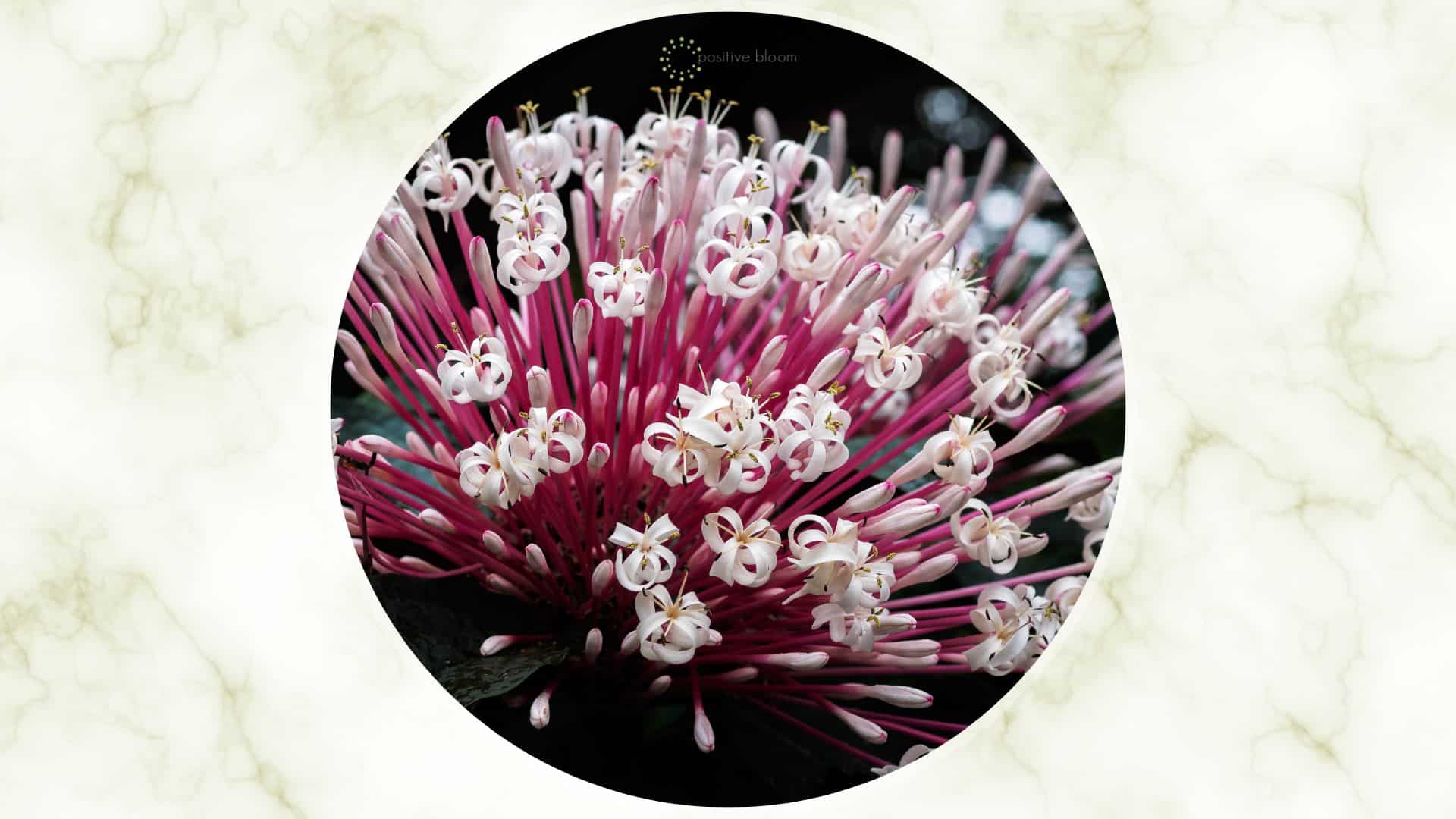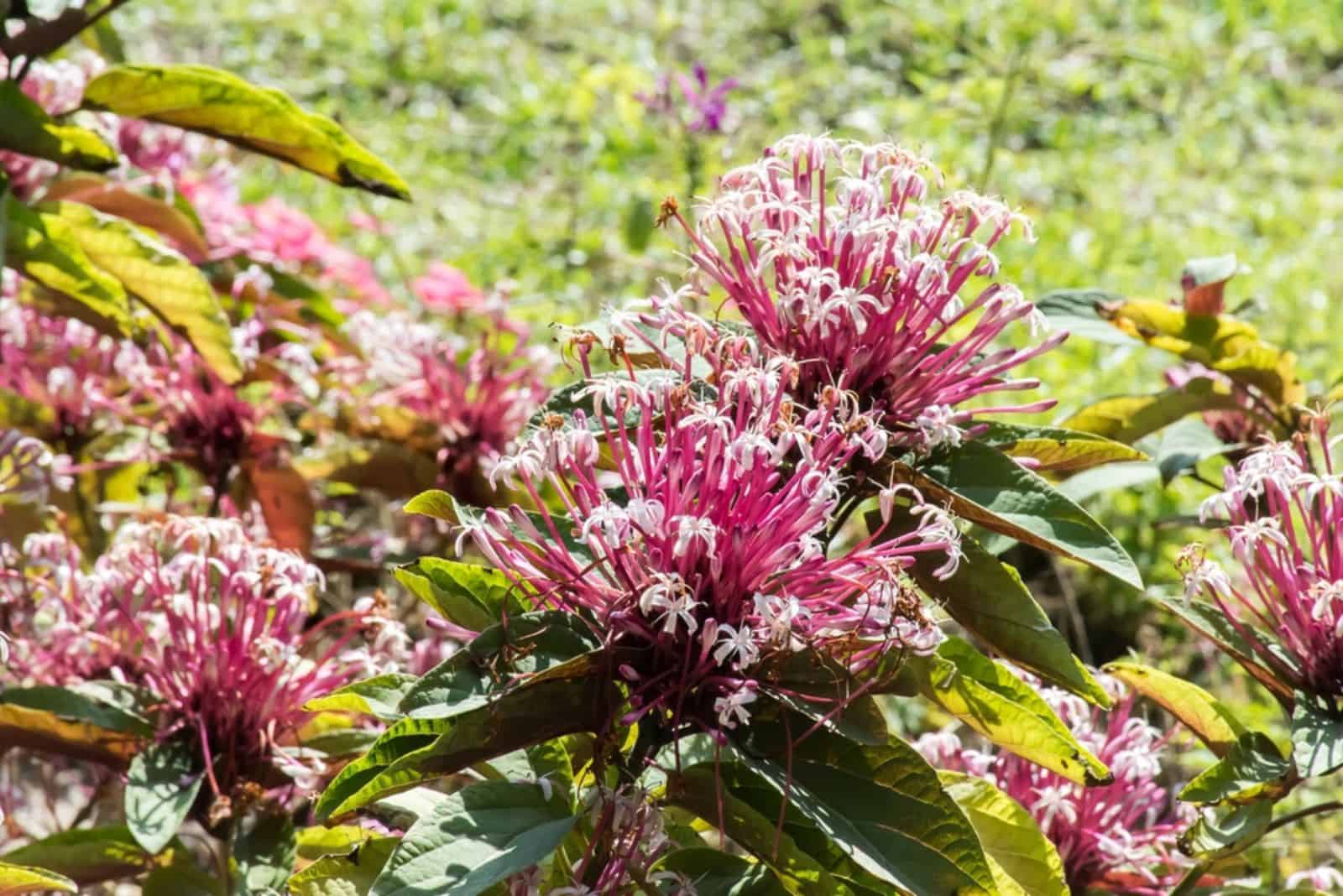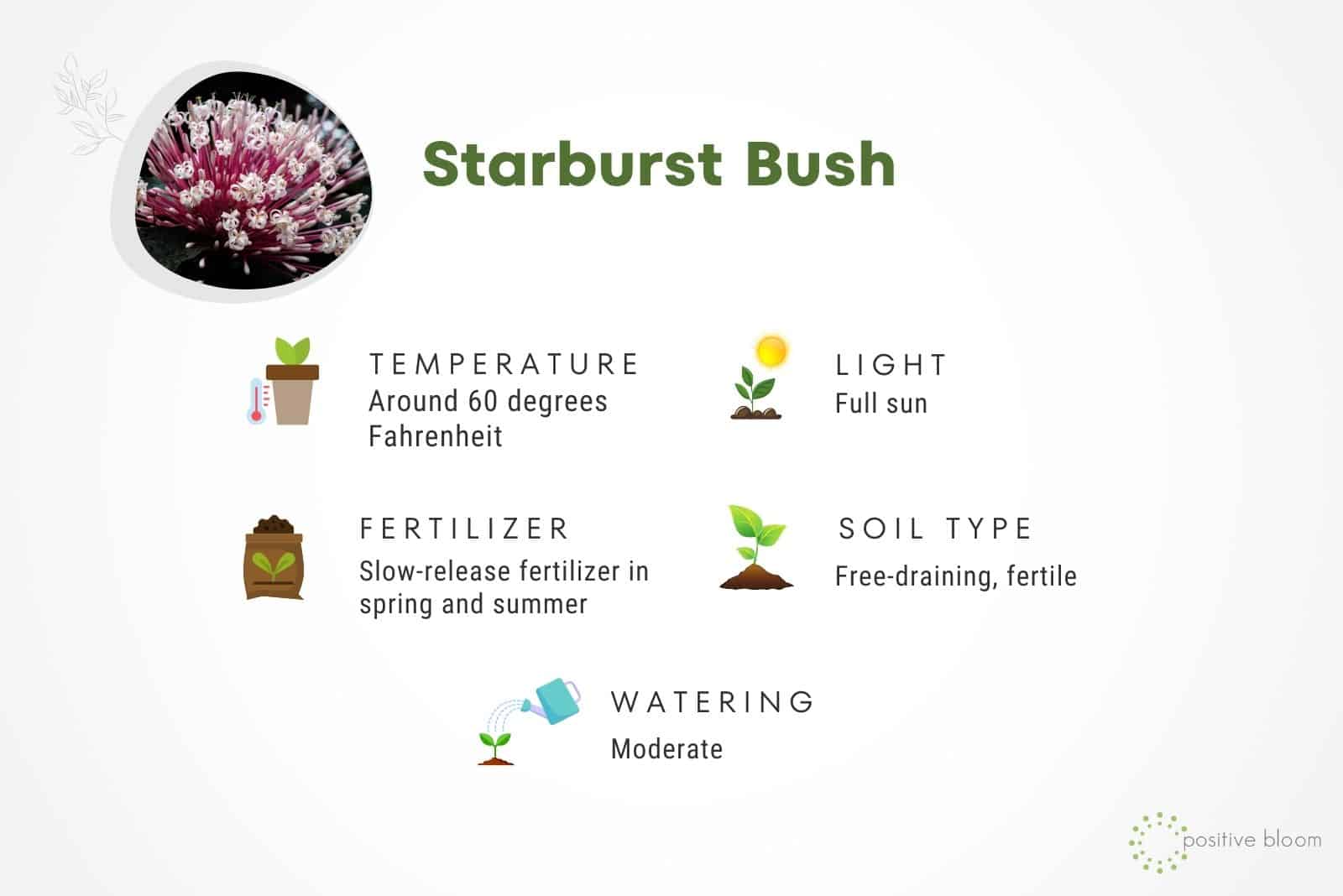Who doesn’t like shooting stars?! If you are a gardener looking for a plant that resembles shooting stars, I have the perfect option for you.
Meet the Starburst bush, a breathtaking tree that will make your landscape prettier than ever.
This is a pretty uncommon type of tree, so you might be the first one to have it in your area. It produces wonderful blossoms, so you should do anything to help it thrive.
In this article, I’ll tell you more about the Starburst bush and its care requirements, and I’ll also describe how to propagate the tree and solve some potential issues.
Let’s take a look at some basic information about the plant:
[table id=662 /]
What Is The Starburst Bush?
The Fireworks plant is a type of tree native to New Guinea and the Philippines. It belongs to the Clerodendrum genus, and you’ll frequently find the genus under the name “Glorybower”.
What makes the Starburst bush so special? Let’s start with the blossoms, which emerge in the winter or early spring, so your backyard will be full of flowers at the most beautiful time of the year!
The blossoms look like tiny stars; they develop into clusters and their stalks resemble the tails of shooting stars. The combination of white and pink hues on the flowers gives a spectacular view! The flowers aren’t just pretty, but also beneficial because hummingbirds adore them!
My 5-year-old cousin says that the stem of the flowers looks like a Q-tip. I hope he will use better words to describe the beauty of the flower in the future!
Another amazing thing about the Shooting star Clerodendrum is the foliage. The surface of the leaves is deep green with a bit of purple, and what makes them truly special are the undersides that come in dark purple. The combination of colors on the Starburst bush is truly amazing.
You can expect your Starburst bush to reach 15 feet tall when mature.
I’m sure you are wondering if this tree has any drawbacks. Well, nothing is perfect; the Clerodendrum quadriloculare is listed as invasive in some regions of the world.
Although it’s not invasive here in America, I still advise you to be careful.
How To Care For The Starburst Bush
Honestly, I always thought that trees of this kind were kinda hard to maintain. Luckily, I was wrong.
The good news is that it’s really easy to keep your Shooting star Clerodendrum healthy and happy.
Let’s see what that means:
Light Requirements
There’s one phrase that perfectly describes the light requirements of the Firecracker plant: sun-loving!
So, if you want to encourage the production of breathtaking blossoms, provide your tree with plenty of sun.
I have to mention that the Firework tree will grow well in partial shade, but the foliage won’t be as dense and the flowering season will be over pretty quickly.
Therefore, ensure a sunny spot for this Clerodendrum tree for the best results.
How And When To Water The Starburst Bush
When it comes to watering the Shooting star Clerodendron, your goal is to keep the soil moist, but not soggy. This mainly refers to a younger Starburst bush.
You need to be extra careful during the hot summer months because your tree loses more water when temperatures are high.
As soon as your Shooting star Clerodendrum is established, its watering needs will significantly change and it’ll become kinda drought resistant. If you live in a rainy area, your Clerodendum can survive solely on rain.
If rainfall is sparse, you can water now and then.
For instance, if it hasn’t rained for 3 weeks, you should give your Firecracker plant a good soak.
Temperature Requirements
The ideal temperature for the Winter starburst is around 60 degrees Fahrenheit, which means the tree is hardy in zones 9b through 11.
The lowest temperature this Cleronedendrum plant can tolerate is 5 degrees Fahrenheit.
Pay attention to the watering schedule when temperatures are higher or lower since underwatering and overwatering can affect the growth of your Starburst.
Soil Type
I mentioned that you need to keep the Firecracker tree’s soil constantly moist. In order to prevent waterlogging, which can have fatal consequences, you need to ensure this plant has a free-draining soil type.
Regarding pH level, a range of 6.1 to 6.5 is ideal for your Clerodendrum.
There’s one method that can aid moisture retention in summer and protect your Starburst from cold in winter, and it’s called mulching. A layer of mulch will do wonders during hot summers and cold winters.
Fertilizing Schedule
Since the Shooting star Clerodendrum produces blooms, it will benefit from fertilizing. This is the best way to encourage blossoming and retain vigor.
Regarding fertilizer type, I recommend applying slow-release, granular fertilizer in the fall and early spring. All-purpose fertilizer is typically used for the Starburst bush, but there are some other types you can use.
For instance, nitrogen and phosphorus are essential for flower production, so fertilizers with higher concentrations of these two minerals will work best.
Pruning
Trimming the Fireworks plant isn’t something you should skip. The first reason your Clerodendrum needs pruning is to keep it healthy by removing diseased or damaged branches.
The second reason is to encourage bushier growth.
Incredible blossoms will appear on the pruned stalks when the growing season begins.
Interestingly, you can trim your Fireworks plant to get the shape of a small tree. This may be time-consuming and challenging, so if you are a beginner you should stick to standard pruning.
The end of the winter or early spring is the best time to prune this Clerodendrum plant. You can actually remove the top 6 feet of your tree to encourage growth and get the desired shape.
All damaged or diseased Starburst branches should be instantly removed as they might still be consuming nutrients that would otherwise be directed to flower production.
How To Propagate The Starburst Bush
Now the part we have all been waiting for – getting more Starburst trees! If you’re afraid this plant will take over your yard, simply plant the cuttings you take in containers.
Wait until new shoots occur after pruning, and cut off 4-inch long shoots to propagate.
You can plant the Starburst cuttings in the soil or use water propagation. You’ll have great results if you use compost as a rooting medium. Make sure you keep the Fireworks plant cutting in a humid room that gets a lot of bright indirect sunlight.
When new roots emerge, transfer the Starburst cuttings to their new container and cover it with a transparent plastic bag.
Keep the soil evenly moist and transplant the cutting as soon as it develops new stems.
Common Issues With The Shooting Star Clerodendrum
We’ve seen that this Clerodendron is pretty hardy when fully established, but I definitely wouldn’t refer to it as a problem-free tree.
Let’s look at some potential problems with the Winter starburst tree and how to fix them!
Pests
I know what you might be thinking: is there any plant that doesn’t have issues with pests? Well, sorry, but no.
Aphids, spider mites, scale, leafhoppers, whiteflies, and mealybugs are the pests that can infest your Starburst. Yes, the number is high, but if you check on your Firecracker plant regularly you can fix the issue quickly if some pests appear.
The easiest way to prevent pests from attacking your Starburst is by taking good care of it. Pests are most likely to infest weak plants, and the problem is that they can transfer diseases, so prevention is the best cure.
If you are dealing with a severe infestation, I advise seeking professional help.
Nutrient Deficiency
Starburst foliage will most likely turn yellow if the tree lacks nutrients. You should take this seriously as your Firecracker can die off if you don’t fix this issue.
I recommend adding water-soluble fertilizer. They’ll boost levels of all the nutrients essential for the healthy growth of your Starburst bush.
Wrapping Up
If you are looking for a new tree to add to your backyard, now you have the best option possible.
The Starburst bush is a magnificent cultivar from the Lamiaceae family. It’s not fussy over the growing conditions and will produce stunning blossoms with a little bit of encouragement.
Make sure the spot where you plant your Shooting star Clerodendrum receives a lot of full sun and that the soil is free-draining and fertile.
Inspect the tree from time to time to avoid potential pest or nutrient issues. Follow our guide, and I’m sure your Firecracker plant will flourish and reward you with the most spectacular blossoms the plant world has ever seen!
Until next time!




